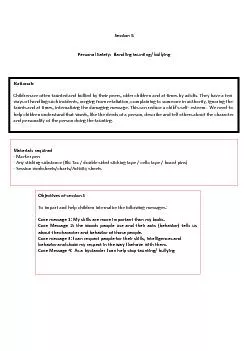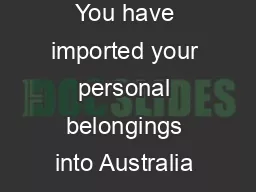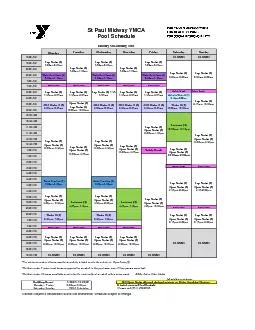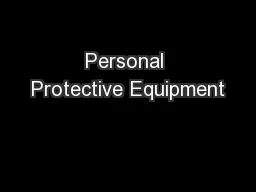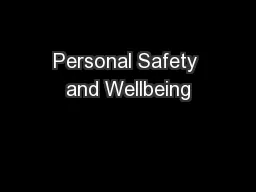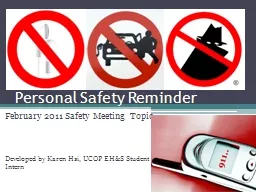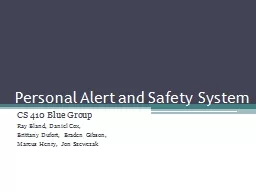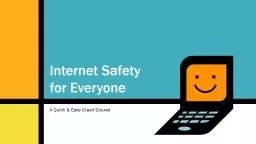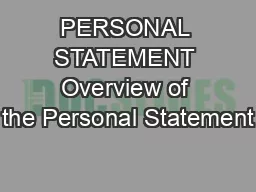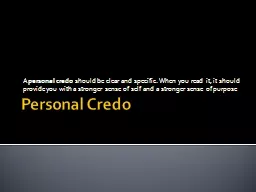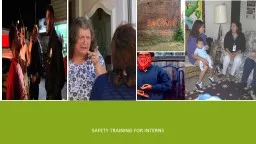PDF-Personal Safety:
Author : debby-jeon | Published Date : 2015-11-11
Session 5 Handling taunting bullying Rationale Children are often taunted and bullied by their peers older children a nd at times by adults They have a few ways
Presentation Embed Code
Download Presentation
Download Presentation The PPT/PDF document "Personal Safety:" is the property of its rightful owner. Permission is granted to download and print the materials on this website for personal, non-commercial use only, and to display it on your personal computer provided you do not modify the materials and that you retain all copyright notices contained in the materials. By downloading content from our website, you accept the terms of this agreement.
Personal Safety:: Transcript
Session 5 Handling taunting bullying Rationale Children are often taunted and bullied by their peers older children a nd at times by adults They have a few ways of handling such incidents rangi. Lifestyles Fitness provides the opportunity for clients to make gradual permanent changes that they can incorporate into their everyday lives. Imported personal belongings may arrive in Australia by air or sea cargo or by international mail post Personal belongings are also known as unaccompanied personal effects UPEs UPEs may include clothing books furniture appliances and sporting equipm Safety Break Safety Break Safety Break Safety Break Safety Break Safety Break Lap Swim (2) Open Swim (2) Lap Swim (2) 10:00am-4:25pm Open Swim (2) 12:10pm-2:30pm Safety Break Safety Break Safety Bre Safety While Wearing PPE. Safety Concerns. Physical. Psychological. Environmental. Biological. Just In Time Training. Personal Protective Equipment: Safety. Physical Constraint. Restricts movement. Limits mobility. Session 2 Personal relationships staying safe . City of Wolverhampton College . Multifaith Chaplaincy . and . Student Wellbeing. Personal Safety and Wellbeing . Session 2 Personal relationships Cyber safety. Learning objectives. To understand the importance of food hygiene and food poisoning. To understand what are classed as high risk foods. To Understand why bacteria makes us ill. To Understand how bacteria multiply. February 2011 Safety Meeting Topic. Developed by Karen Hsi, UCOP EH&S Student Intern. Be Aware of Your Surroundings. Don’t allow distractions such as music or texting make you a target for theft or assault.. CS 410 Blue Group. Ray Bland, Daniel Cox,. Brittany Dufort, Braden Gibson,. Marcus Henry, Jon Szewczak. Societal Problem Statement . In the event of a personal emergency, security professionals at higher education, business and civil complexes need an effective way to allow individuals to quickly and silently communicate their location to first responders.. or Everyone. A Quick and Easy Crash Course. But I already know how to use. . the Internet!. You use the Internet every day, and nothing bad has happened so far. So you must know all about Internet safety, right? . Personal statements are sometimes also called "application essays" or "statements of purpose.". Whatever they are called, they are essentially essays which are written in response to a question or questions on a graduate or professional school application form which asks for some sort of sustained response.. should be clear and specific. When you read it, it should provide you with a stronger sense of self and a stronger sense of purpose. Definition . A credo is a set of beliefs that drives thoughts and behaviors. . Personal Safety safety training for interns Bonnie Rinks, LCSW, ACSW director of Field Education PERSONAL SAFETY Look Out for Your Own Welfare As Social Workers (and social work interns), we often After you begin your search for Marine safety equipment supplier you need to be able to recognize the type of equipment you will need to buy. This can be very simple once you have become acquaint with your states rules and system and have also determined. The NESTA Personal Fitness Trainer Certification is accredited through the National Commission for Certifying Agencies (NCCA), the gold standard. Fitness centers, health clubs and gyms are hiring NESTA personal fitness trainers every day. Get certified now so you can get hired fast.
Download Document
Here is the link to download the presentation.
"Personal Safety:"The content belongs to its owner. You may download and print it for personal use, without modification, and keep all copyright notices. By downloading, you agree to these terms.
Related Documents

